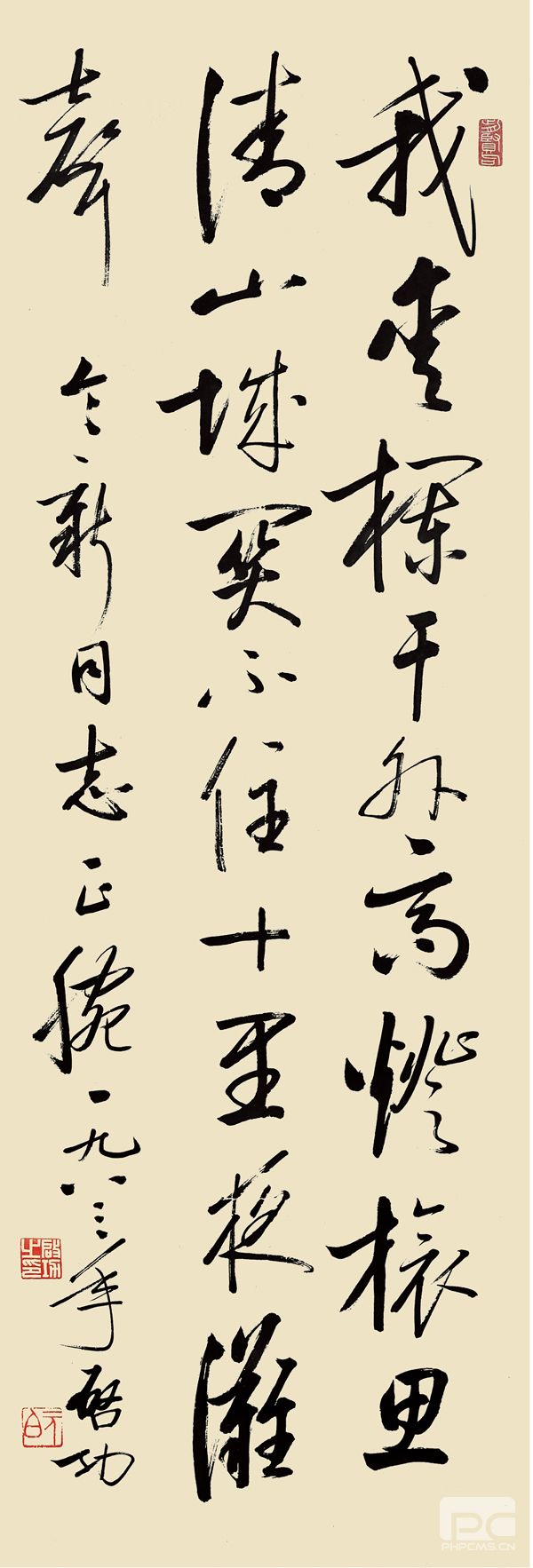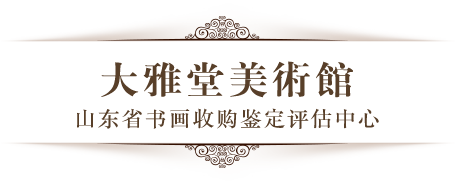材料与笔墨,是形式和形象的关系,更是古董鉴定常说的书画鉴定中的两要素。材料是“死”的,笔墨是“活”的。前者易言传,后者难意会。原因很简单,对于“死”的东西,只要有充分的时间,科学的分析,一般人是可以接受的。但不排除也有钻牛角不解之人。对于“活”的东西,不是时间能解剖其中之秘要。笔墨需要人用激情去感悟,用大脑去理解。当然没有大量的资料,没有渊博的知识,是不可能做到的。每个人的知识与理解程度不同,接受能力亦自然不一。
Material and ink are the relationship between form and image, and are also the two elements commonly referred to by antique appraisal experts in calligraphy and painting appraisal. The material is' dead ', and the ink is' alive'. The former is easy to convey, while the latter is difficult to comprehend. The reason is simple. For things that are 'dead', as long as there is sufficient time and scientific analysis, ordinary people can accept them. But it cannot be ruled out that there are also people who are unable to understand. It is not time that can dissect the secrets of what is' alive '. Pen and ink require people to perceive with passion and understand with their brains. Of course, without a large amount of information and profound knowledge, it is impossible to achieve it. Everyone has different levels of knowledge and understanding, and their receptivity naturally varies.

材料指的是书画家创作以外的东西。具体分纸(绢)质,墨色,颜料,印泥四部分。表面上看,这四点没有多大学说。 其实不然,特别是在鉴定远古书画作品时,材料的区分可以直接对某些膺品作出科学的论断,无须深入。 比如一幅明代的书画,如果发现作品的材料不到年纪,或者是新的, 就根本不用再深入研究,要知道,古人是不会用后人的东西。
Materials refer to things that are not created by calligraphers and painters. Specifically, it is divided into four parts: paper (silk) quality, ink color, pigment, and printing mud. On the surface, these four points do not have much theory. In fact, it is not the case, especially when identifying ancient calligraphy and painting works, the distinction of materials can directly make scientific judgments about certain counterfeits without going deep. For example, if a painting or calligraphy from the Ming Dynasty is found to have materials that are not old or new, there is no need to delve deeper into it. It should be noted that ancient people did not use things from later generations.
材料学说基本可以概括成一定义:一点假即全假,也就是说发现材料的其中一点是假的,就可以断定整件作品是假的!于书画作品残破接笔, 不能笼统概括混合其中,应另开思路科学对待! 虽说材料一点假即全假,但是,材料真不一定作品真,同时代的仿品,老纸新作等膺品存世量巨大, 只有在肯定材料的基础上,鉴定才有必要深入研究。
The material theory can be basically summarized as a definition: a little bit of falsehood is all falsehood, which means that if one point of the material is found to be false, it can be concluded that the entire work is false! As for the fragmented brushstrokes in calligraphy and painting works, they cannot be generalized and mixed together, and should be treated scientifically with a different approach! Although the materials may be fake at all, the authenticity of the materials does not necessarily mean the authenticity of the works. There is a huge amount of contemporary imitations, old paper and new works, etc. Only on the basis of affirming the materials can it be necessary to conduct in-depth research in appraisal.
值得补充的是,新手对于一些用老纸,老墨,老颜料,老印泥制造的伪作,会产生一定的疑惑,其实这个疑惑是很天真的, 因为墨, 颜料, 印泥只有在纸质上使用之后,经过长时间氧化,才能体现出它的古气,现成使用这些老材料,出来的效果其实和新材料相差无几,是很容易分辨的。 除了同时代的仿品以外,现成的任何伪作是没有古气的。 总之,材料是鉴定的基础,在鉴定过程中,应严谨对待,不可轻视。
It is worth adding that beginners may have some doubts about some counterfeits made from old paper, ink, pigments, and printing paste. In fact, this doubt is very naive, because ink, pigments, and printing paste can only show their ancient style after being used on paper for a long time after oxidation. The effect of using these old materials now is actually similar to that of new materials, and it is easy to distinguish. Except for contemporary imitations, any ready-made forgery is devoid of antiquity. In short, materials are the foundation of appraisal, and in the appraisal process, they should be treated rigorously and not underestimated.
笔墨是作者创作之心境,笔墨是作品表达之语言。笔墨可以反映出书画的时代气息,个人风格, 鉴定一件作品,要熟悉作品的时代气息,进而了解作者的生活年代,活动场所, 然后研究作者不同年代不同的风格,这些知识有些是掌握的,有些是可以灵活推理,毕竟书画历史悠久,名家辈出, 存世量巨大,任何鉴定家不可能涉足书画之全部。
Pen and ink are the author's creative mood, and pen and ink are the language of expression in the work. Pen and ink can reflect the era atmosphere and personal style of calligraphy and painting. To identify a work, one must first familiarize oneself with the era atmosphere of the work, then understand the author's era of life and activity venues, and then study the author's different styles in different eras. Some of these knowledge are mastered, while others can be flexibly inferred. After all, Chinese calligraphy and painting has a long history, with many famous artists and a huge amount of surviving world, No appraiser can touch upon all aspects of Chinese calligraphy and painting.
作品的时代气息,是证实作者生活年代,活动场所的前提。我们知道,在书画发展史上,同一个时代,不同的地域,都活跃着不同的书画流派,所以,当熟悉了作品的时代气息,就可以深入分割研究不同地域的不同流派,二者前后融会贯通,从而达到鉴定的目的。笔墨是鉴定书画时代气息的法宝,也是鉴定的必经之路,鉴定书画时代气息以笔墨入手。
The contemporary atmosphere of the work is a prerequisite for confirming the author's era of life and place of activity. We know that in the development history of Chinese calligraphy and painting, different schools of calligraphy and painting are active in the same era and different regions. Therefore, once you are familiar with the contemporary atmosphere of the work, you can deeply divide and study different schools in different regions, and the two are integrated before and after, thus achieving the purpose of identification. Pen and ink are the magic weapon for identifying the atmosphere of the calligraphy and painting era, and are also the necessary path for identification. Identifying the atmosphere of the calligraphy and painting era starts with pen and ink.
This article is dedicated to the acquisition of celebrity calligraphy and painting. For more information, please click https://www.jndyt888.com Sincere attitude. We will provide you with comprehensive services. We will gradually contribute more relevant knowledge to everyone. Stay tuned

 发布时间:2023-11-04
发布时间:2023-11-04  作者:大雅堂美术馆
作者:大雅堂美术馆  文章来源:https://www.jndyt888.com/
文章来源:https://www.jndyt888.com/  浏览量:0
浏览量:0
